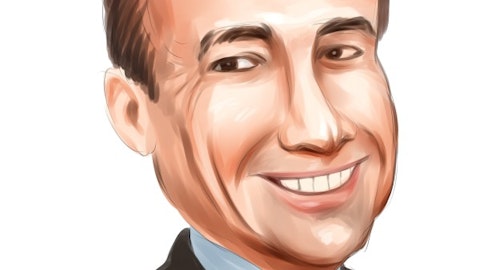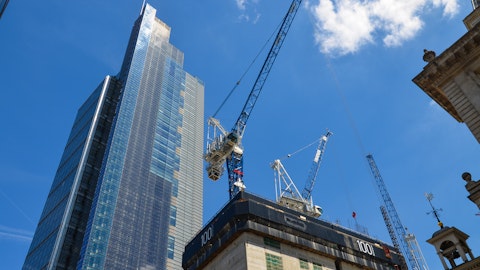Apogee Enterprises, Inc. (NASDAQ:APOG) Q2 2024 Earnings Call Transcript September 19, 2023
Apogee Enterprises, Inc. beats earnings expectations. Reported EPS is $1.36, expectations were $1.12.
Operator: Hello and welcome to Apogee Enterprises, Inc. Q2 2024 Earnings Conference Call. At this time, all participants are in a listen-only mode. After the speaker’s presentation, there will be a question-and-answer session. [Operator Instructions] I would now like to hand the conference over to Jeff Huebschen. Sir, you may begin.
Jeff Huebschen: Thank you, Towanda. Good morning, and welcome to Apogee Enterprises Fiscal 2024 Second Quarter Earnings Call. With me today are Ty Silberhorn, Apogee’s Chief Executive Officer; and Matt Osberg, Chief Financial Officer. I’d like to remind everyone that there are slides to accompany today’s remarks. These are available in the Investor Relations section of Apogee’s website. During this call, we will reference certain non-GAAP financial measures. Definitions of these measures and reconciliation to the nearest GAAP measures are provided in the earnings release and slide deck we issued this morning. I’d also like to remind everyone that our call will contain forward-looking statements. These reflect management’s expectations based on currently available information.

Actual results may differ materially. More information about factors that could affect Apogee’s business and financial results can be found in today’s press release and in our SEC filings. And with that, I’ll turn the call over to you, Ty.
Ty Silberhorn: Thank you, Jeff. Good morning, everyone, and thanks for joining us. Apogee has delivered another terrific quarter as we continue to advance our strategy. Let me touch on some highlights from the quarter and connect those to how our strategy continues to drive sustainable improvements in our business. Then I’ll turn it over to Matt for more details on the quarter and our outlook. Let’s start with the highlights, which are on page four in our presentation. Overall, this was another strong quarter that continued the positive momentum we’ve established the past two years. We are especially pleased to report an operating margin that exceeded our 10% target for the first time since we established our financial goals in late 2021.
This margin expansion drove adjusted earnings per share to a new quarterly record. I’m proud of our team for the work they’ve done to achieve these milestones. Just as importantly, we’ve demonstrated that we can meaningfully grow profit dollars and cash flow even in an environment without meaningful volume growth. Once again, Architectural Glass led the way, continuing their revenue and profit growth trend. As a reminder, when we began our strategic transformation two years ago, the Glass segment had operating margins in the low single-digits. We’ve now achieved eight consecutive quarters of sequential margin improvement. I’d like to recognize the entire Glass team for this tremendous success. Our improved results are being driven by our three-pillar strategy, which is highlighted on page five in our presentation.
We’ve made great progress towards becoming an economic leader. We better defined our target markets. We’re focused on differentiated products and services, we’ve built more competitive cost structures, and we’ve made great strides to improve operational execution. In our second pillar, actively managing the portfolio, we’ve taken steps to shift our portfolio to higher margin offerings, which drive improved ROIC performance. We’re making investments to scale and grow our top-performing businesses. We’ve implemented focused improvement plans to strengthen underperformers, and we are increasing the mix of differentiated offerings across our portfolio. Finally, we are strengthening our core capabilities. The foundation of this is deploying the Apogee Management System, which is our approach to lean and continuous improvement.
We are also continuing our shift from a decentralized operating model to one with center-led functional expertise that better supports the needs of our business. And we are improving our approach to talent management and talent development at all levels of the organization. As we move forward, we see significant opportunities to continue to build on this success. When we announced our new financial goals in 2021, we had operating margins in the low to mid-single digits, and we were not earning our cost of capital. As we began to execute our strategy, improving margins and ROIC was the primary focus, especially in Glass and Framing Systems, which were underperforming their potential. In several cases, we made the strategic decision to move away from lower-margin sales where we did not have differentiated offerings.
Now that we have substantially improved our margins and our earning above our cost of capital, it is appropriate to shift more focus to driving profitable revenue growth. We are making strategic investments that will enable organic growth. We are leveraging our improved execution and service levels to gain market share. We are working to further diversify our project mix in the higher growth sectors. And we continue to explore potential acquisition opportunities that support our strategy, accelerate our growth and our diversification. These efforts will create opportunities across the enterprise to drive above-market growth in the years ahead. We will do this while sustaining the things that have made us successful these past two years, staying focused on driving productivity and execution, carefully managing our cost structure and further strengthening our results driven culture.
With that, let me turn it over to Matt.
Matt Osberg: Thanks, Ty, and good morning, everyone. First, I’ll begin with an overview of our second quarter results and then turn to our updated outlook for the full fiscal year. As we look at our second quarter results, despite revenue declining 5%, it was another strong earnings quarter. Adjusted diluted EPS grew 28% to a record level of $1.36. We also expanded operating margin by 290 basis points to 11.5. Consolidated revenue was $354 million for the quarter, compared to $372 million last year, primarily reflecting lower volumes in Services and Framing. This was partially offset by strong growth in Glass, which was up 22%. The growth in Glass was driven by improved volume, pricing and mix, reflecting our continued strategic shift towards higher-value premium products.
In our Services segment, revenue recognition is mainly a function of the stage projects are in and how much work has been completed. Compared to the second quarter of last year, in the current year, we had a higher mix of products that are early in their life cycle, which drove lower levels of revenue being recognized in the current quarter. The revenue decline in Framing was primarily driven by lower volumes, reflecting elevated volumes in the prior year as we work to reduce lead times to drive a reduction in backlog. This was partially offset by a more favorable product mix. Consolidated operating income increased 26% and operating margin expanded 290 basis points to 11.5%, primarily driven by strong sales and margin improvement in Glass.
Segment operating income per Glass nearly tripled to $17.5 million, up $17.4 million, up from $6.5 million last year. The Glass segment operating margin improved to 18.5% over a 10 percentage point increase compared to last year and reflects favorable operating leverage and benefits from pricing and mix. Framing grew segment operating income 3% and expanded segment operating margin by 140 basis points to 13.3%, driven primarily by improved mix and cost efficiencies partially offset by the impact of lower volume. Both Services and Large-Scale Optical segment operating margins were down primarily due to the impact of lower volume. However, Services improved margins sequentially from the first quarter and we expect Services margin to continue to improve in the second half of the year.
Corporate expenses of $6.1 million were in line with prior year, however, we’re less than the first quarter of fiscal ’24, primarily due to lower insurance-related costs. While our corporate costs can have variability from quarter-to-quarter, we expect the run rate for the third and fourth quarters to trend more closely with the levels experienced in the first quarter. This quarter, we recognized a $4.7 million pretax benefit from a New Markets Tax Credit, which was recorded in other income. The New Markets Tax Credit is a federal program that encourages investments in local communities. The credit we realized this quarter was related to investments we made seven years ago. We have two similar tax credits pending, which we expect to recognize in fiscal year ’26.
Our tax rate in the quarter was 22.9%, below our long-term rate assumption of 24.5% due to the favorable impact of discrete tax items. Adjusted EPS grew 28% to $1.36 primarily driven by higher operating income. EPS was also benefited by a lower diluted share count, which reflects our share repurchase activity over the past two quarters. Looking at backlog trends for the quarter on a sequential basis, backlog for Framing was $197 million compared to $221 million in the first quarter. The reduction was driven primarily by a decline in our longer cycle business, reflecting delays in award activity and continued strategic shift towards projects that allow for more attractive margins. Services finished the quarter with $674 million in backlog compared to $709 million last quarter, primarily reflecting delays in award activity.
We had another strong quarter of cash flow as we generated $41.3 million of cash from operations, an improvement of $13.5 million over last year. This brings year-to-date operating cash flows to $62.6 million, an improvement of $65.2 million compared to the first half of last year. This was primarily driven by improved working capital as the first half of last year had unfavorable working capital impacts related to sales growth and inflation. We had capital expenditures of $7.6 million in the second quarter, primarily relating to investments to expand capacity in our higher-margin businesses and enhanced productivity through automation. We also returned nearly $12 million in cash to shareholders through dividends and share repurchases and we paid down $25 million in debt in the quarter.
This debt reduction further strengthened our balance sheet with our net leverage ratio coming down to 0.7 times trailing 12-month adjusted EBITDA. Turning to our updated fiscal year outlook. We are increasing our full year adjusted diluted EPS outlook to a range of $4.35 to $4.65, primarily reflecting the strong results in the second quarter. This updated outlook implies full year adjusted EPS growth of 9% to 17% compared to last year’s adjusted diluted EPS of $3.98. We also continue to expect flat to slightly declining net sales for the fiscal year. As a reminder, fiscal ’24 is a 53-week year with an extra week of operations in the fourth quarter. For the full year, the extra week is expected to add approximately two percentage points of growth to revenue.
Our outlook range contemplates the latest market forecast, which point to a potential slowdown in non-residential construction in the second half of our fiscal year. Any impact of this would more quickly affect the shorter cycle businesses within Framing and Glass. As in past years, we expect the fourth quarter will be the lowest revenue and margin quarter for Framing due to the seasonality of the winter construction season. We expect Framing margins for the full year will be near the top of its 9% to 12% target range. For Glass, although we expect revenue growth and margin levels to moderate in the second half of the year, we expect the full fiscal year operating margin to be toward the higher end of the 10% to 15% target that we articulated last quarter.
We expect Services revenue and operating margin to increase in the second half of the year compared to the first half, primarily due to the progression of work on active projects. Although Services margins should improve as we move through the year, we expect that it will likely fall short of the 7% to 9% target range for the fiscal year. We expect sales and margins in Large-Scale Optical to improve sequentially in the second half of the year as customer inventory levels rebalanced. As I mentioned earlier, we expect corporate cost for the third and fourth quarters to trend more closely with the level of expense we incurred in the first quarter. We continue to expect an average tax rate of approximately 24.5% and full year capital expenditures of $50 million to $60 million.
We also continue to expect both operating and free cash flow growth for the full year. We are very pleased with the earnings results we have delivered in the first half of the fiscal year with adjusted diluted EPS growth of 17% and operating margin expansion of 140 basis points despite declining sales. We are focused on delivering the back half of the year and continuing to drive our strategic initiatives to set us up for fiscal ’25 and beyond. As we look ahead to fiscal ’25, we are monitoring macroeconomic trends and industry data to assess potential impacts on our business. As we begin our planning process for next fiscal year, we will stay focused on driving long-term shareholder value and will take a balanced approach for any short to mid-term market changes while maintaining investment and momentum behind our most critical strategic initiatives.
We are approaching fiscal ’25 with a growth mindset, a focus on driving further productivity gain, and a balanced approach to cost control and strategic investments. While we have been able to expand operating margins significantly over the past two years, we believe that we have further positive margin building blocks yet to realize. We believe that fiscal ’25 margins will be helped by further productivity and AMS initiatives and improved project pipeline and services, continued emphasis on improving mix and framing and potentially using our strong balance sheet for attractive M&A. Additionally, although we expect Glass segment margin rates to moderate in fiscal ’25, we are focused on maximizing margin dollars while delivering margin rates within our target range of 10% to 15%.
As a reminder, fiscal ’25 will revert to a normal 52-week year, which will be a headwind for year-over-year comparisons. In closing, we are pleased with our second quarter and first half results as well as our continued progress to advance our strategic objectives and drive improved profitability. This improved profitability will better position us to outperform throughout the market cycle. Additionally, our strong cash flow and balance sheet position us for further value-creating capital deployment, investing in our business and returning cash to shareholders. With that, I’ll turn it back over to Ty for some concluding remarks.
Ty Silberhorn: Thanks, Matt. To wrap up, I want to recognize our team once again for their tremendous efforts in advancing our strategy. Through their work, we have exceeded our 10% margin target less than two years since we set this goal. And we’re not done as we’ll continue building on these achievements. While we see some signs of softening in the broader non-residential market, we are seeing positives that play to our strengths and strategic focus. Premium Class A office space is still seeing solid demand and many research firms predict this area will perform better than the broader office segment. We’re seeing a higher rate of mixed-use buildings that blend office, retail and residential. Institutional and transportation projects remain strong.
And there’s a renewed focus on sustainability and green buildings. Our current backlog reflects many of these trends, while future acquisitions could accelerate our growth and diversification. We also expect to drive additional productivity gains through the Apogee Management System and further improve operational execution. We’re proud of the progress to date and we continue to see significant opportunities to deliver long-term above-market growth across our business. With that, we are ready to take your questions.
See also 13 Best Beaten Down Stocks To Buy Now and 12 Best Alcohol Stocks to Own According to Hedge Funds.
Q&A Session
Follow Apogee Enterprises Inc. (NASDAQ:APOG)
Follow Apogee Enterprises Inc. (NASDAQ:APOG)
Operator: Thank you. [Operator Instructions] Our first question comes from the line of Chris Moore with CJS Securities. Your line is open.
Chris Moore: Good morning, guys. Congrats on a very nice quarter.
Ty Silberhorn: Good morning, Chris.
Chris Moore: Maybe we’ll just start on the framing operating margin. Obviously, Q2, very strong 13.3%. You talked about efficiencies from lean and mix. Can you maybe just talk a little bit more about kind of what mix means within the Framing? Are we talking about types of projects, quick turn versus longer? Is it types of buildings? Just anything else in terms of kind of that mix component.
Ty Silberhorn: Sure. It’s a great question, Chris. There’s a couple of things going on in Framing. One, our shorter-cycle business we see stronger margins and as that business has recovered on service and lead time levels. Last year, in their second quarter, they were catching up and really cleaning up and you saw that the backlog dropping, which was a positive thing for the short-cycle portion of that business because it had built up through some extended lead times due to some supply chain issues. So that was one issue that they were working through from a year-over-year comp perspective. Revenues last year were a bit increased or up a bit for them because of that recovery. But as we are going through that, that short cycle business with that service differentiation, we are able to get some stronger margins than other parts of the business.
So we’ve continued to invest and the team is driving their focus to accelerate and grow more of that business. The project-related business has always had some lower margins compared to the short-cycle business. And there’s two things going on there. One, the team is being much more selective about where I think you can differentiate and capture value both for the customer and us, which would translate into some better margins. And then we’ve encouraged the team that if we can’t get margins that help us achieve and sustain our long-term profit goals, then it’s probably business we don’t want on some of that project-related business. So you’re seeing that start to show up in the revenue mix, and you’re also seeing that as a driver in some of the drop in the backlog for that business as well.
Chris Moore: Got it. That’s very helpful. Let me just switch gears, so aluminum pricing bounced around a bit lately, still well below March levels. Is there any kind of likely benefit or penalty from aluminum pricing that timing that’s built into the balance of ’24?
Matt Osberg: Yes. Chris, this is Matt. I wouldn’t say there’s any real material impact built into the back half.
Chris Moore: Got it. And maybe just on cash flow. Obviously, very strong quarter, good six months, cash flows dropped — jumped around a little bit at working capital, as you talked about. At some point, is there a normalized relationship you would expect between free cash flow and say net income? Or is there any other metric that we should be thinking about when looking at kind of a normalized free cash flow?
Matt Osberg: Yes. It’s a great question, Chris. I mean, obviously, we had some unique things that happened last fiscal year, and we’re realizing the benefits of it this fiscal year as that’s becoming more normalized. I think as we look at our opportunities in working capital. There’s still some opportunities for us to get better as we move forward. I think the big driver there will be how we look at our investments in CapEx in the future and how we can fund some of our organic initiatives through CapEx. So, obviously, we have a little bit higher CapEx this year than we have in the past. And as we start looking at fiscal ’25, we’ll figure out how that plays out for next year. But I think this year, we’ll be a little bit more return to a normalized working capital, whereas maybe last year was a bit more of an aberration for what was happening in the markets.
And as we turn the page and start looking at ’25, we’ll get more information on how that’s going to play out next year.
Chris Moore: Got it. And you’re still talking about $50 million to $60 million in CapEx for this year?
Matt Osberg: Yes. Yes. It’s a higher spend in the second half than the first half but just some of the timing of the investments that we’re planning to make just to end up being in the second half.
Chris Moore: Got it. I’ll leave it there. Thanks so much guys.
Matt Osberg: Thank you.
Ty Silberhorn: Thank you.
Operator: Thank you. Please standby for our next question. Our next question comes from the line of Julio Romero with Sidoti & Company. Your line is open.
Julio Romero: Thanks. Hey, good morning. Just wanted to piggyback on the last question about cash usage and how you’re thinking about. It sounded like based on the prepared remarks, you’re really thinking about shifting some focus to growth investments. You talked about maybe a step-up in CapEx in fiscal ’25. Just maybe how much of a step-up in CapEx can we maybe expect in ’25? And it sounds like you might be closer to maybe some inorganic growth opportunities, would that be fair as well?
Matt Osberg: Hey, Julio, this is Matt. I’ll jump in on this and then Ty maybe add. So from a CapEx perspective, I think what I reflected to Chris was fiscal ’24 is a step-up in CapEx from where we’ve been in fiscal ’23. And so I think you can see that. As we look to fiscal ’25, we’re going to start looking at that and what that might mean. I think there are some good opportunities to invest in some organic growth initiatives, but we haven’t gone through that planning process yet. But we want to continue to invest, as we’ve talked about as we look at ’25. We want to continued momentum and invest behind our best strategic initiatives. And so we don’t want to lose any of the momentum that we’re building. But we don’t have numbers yet to kind of project out what that would be in fiscal ’25 yet.
And then from an inorganic perspective, I think we’re always being active in that space. We’ve got the balance sheet ready to do it. And we just continue to look for the best opportunity out there at an attractive price.





